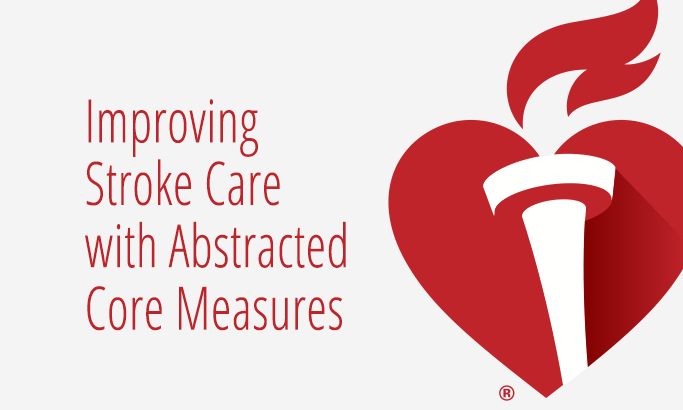How to Use Abstracted Core Measures to Improve Stroke Care

According to the Centers for Disease Control and Prevention (CDC), more than 795,000 people in the United States have a stroke each year. More than 75% of these are first or “new” strokes. The American Heart Association (AHA) reports that on average, someone in the U.S. has a stroke every 40 seconds.
Abstracting core measures isn’t glamorous, but it’s necessary to ensure patients are receiving the best possible care based on established standards.
The AHA’s “Get With The Guidelines” stroke certification program illustrates the power that abstracted core measures have on saving lives.
Four challenges to abstracting measures
The AHA and the American Stroke Association (ASA) started the “Get With The Guidelines” stroke certification program in 2003. Essentially, the AHA and ASA certify hospitals that meet the program’s stroke care performance measures as “stroke care centers of excellence.”
The 87 abstracted core measures taken from the data in patients’ electronic medical records fall into five categories:
- Stroke achievement measures (9)
- Stroke quality measures (10)
- Stroke reporting measures (52)
- Stroke descriptive measures (13)
- Stroke data quality measures (3)
Collecting, abstracting and reporting data on all of the measures in each category can be challenging for a hospital quality department for several reasons:
Challenge #1: The EHR may not have all of the discreet data fields in your patients’ medical record to capture the data for all measures.
Solution: Work with your EHR liaison or health IT representative to capture the required fields into your EHR. You can’t abstract the required core measures data unless your EHR has documentation designed for providers to efficiently record the required information.
Challenge #2: The physicians, nurses and other clinicians who do your charting may not know to include that data in their clinical documentation (whether there’s a field or not).
Solution: Offer training and education to your physicians, nurses and other clinicians on how they should use the new EHR fields within their normal workflows and why it’s important to their patients to capture that data.
Challenge #3: Abstractors may not be aware of changes to specifications for the certification measures in order to pull the data from the EHR accurately.
Challenge #4: One word: compliance. Even if you have all of the right structures in place, everyone still needs to comply with your new clinical documentation requirements.
Solution: You need a robust compliance program. Once you start abstracting the data for your stroke core measures, you’re going to see where the gaps are. From there, start working backward to see where those deficiencies lie and with whom. It may be a department. It may be a unit. It may be an individual doctor or nurse. That’s when training and education should kick in again. You need to teach them how to document and why it’s important to document. You need everyone on board. Otherwise, the system breaks down.
Complying with evidence-based guidelines
Now let’s talk about the most important part of this process: outcomes.
Essentially, when you abstract core measures, you’re measuring compliance with treatment protocols that medical evidence has shown to produce the best possible clinical outcomes for a specific medical condition.
Many measures have to do with timing (how quickly or at what point you take action for a patient). Timing is especially important for stroke patients. The shorter the elapsed time between a patient’s stroke symptoms and diagnosis and subsequent treatment, the better. That’s why you see timing in many of the “Get With The Guidelines” core measures.
For example, the AHA/ASA measures ask you for the percentage of patients who arrived at the hospital within two hours of the first symptom and who received clot-busting drugs within three hours of arriving at the hospital. Other core measures ask what the hospital did for recovering stroke patients at discharge. For example, what percentage of your patients got stroke education on risk factors and warning signs? What percentage got antithrombotic drugs to help reduce the chances of blood clots in the future?
Improving clinical and business outcomes
You’re not just collecting and abstracting the data for certification purposes. You’re collecting and abstracting the data to measure your compliance with clinical protocols that lead to better outcomes for your stroke patients. Higher compliance means more patients with better outcomes. Simply put, this data can save lives.
It also saves money and leads to better business results under your hospital’s value-based reimbursement contracts. Fast diagnosis and treatment can translate into faster recoveries and shorter inpatient stays. Sending stroke patients home with the right discharge instructions and medications can lead to fewer readmissions. And as a “certified center of excellence for stroke care,” you’ll multiply those positive business results as additional health plan providers start sending more of their enrollees to your hospital for care.
Better clinical outcomes for your patients. Better financial results for your CFO. All because you took the time to learn how to abstract core measures for stroke from your EHR system.
IMPROVE OUTCOMES & CUT COSTMedisolv can help your hospitals abstract core measures for stroke care and other medical care from your EHR system. Learn more about ENCOR, our hospital abstracted measure software.
|





Comments